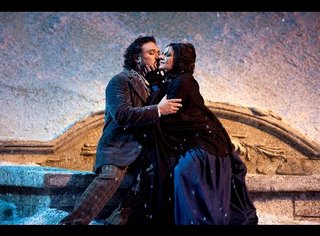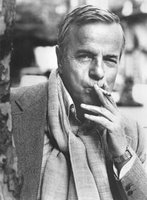by Giuseppe Pennisi
Although Maestro Franco Zeffirelli is approaching the age of 90 (more specifically he will be 87 in a few months), he is still at centre stage of Opera and theatre in Italy and abroad. Next summer, all the Arena di Verona productions will be signed by him. Last September, the comparatively new management of the Metropolitan Opera’s decision to start the 2009-2010 season with a new production of Tosca with the stage direction of Luc Bondy caused an uproar because the audience still wanted Zeffirelli’s 25 year-old staging.
In Rome, the Teatro dell’Opera has serious financial difficulties, and for the last seven months, it has been managed by the Mayor of the City. A new Board was appointed on December 14th – the first meeting is scheduled on December 22nd. Again, in the midst of these troubles, Maestro Zeffirelli is right at the top of Roman and Italian opera goers’ attention. He is the Teatro dell’Opera’s pick for productions to reinvigorate finances; the last production of the 2009 Roman season is his Traviata. The first production of the 2010 Roman season will be his Falstaff, starting January 23rd.
This Traviata was served on a golden plate with, as an appetizer, a major upheaval in the Italian musical world and a likely appendix from the Roman Court of Law. As discussed later in this article, the staging is not new – a very similar Zeffirelli’s Traviata was performed in Rome in 2007. The main attraction was the debut in the title role of Ms. Daniela Dessì, with her life companion Mr. Fabio Armilliato as Alfredo; they were expected to sing at two gala performances on Dec 27th and New Year’s Eve. But Zeffirelli objected to her taking up Violetta on the grounds that she was getting along in age and weight. There was no Artistic Director to counteract him. Things got really heated at the press conference when strong words were exchanged. Ms Dessì cancelled all her contracts with the Rome Opera, including her much awaited performance as Alice Ford in Falstaff. Mr. Armilliato followed suit. Now, the matter is in the hands of lawyers and judges. Finally, during the press conference, Maestro Zeffirelli delivered a strong speech against the new way of staging Traviata (and other operas) in brothels (Irina Brook, Graham Vick), cemeteries (Laurent Pelly) as well as against updating opera plots to our time and age. This stirred up a lively controversy also on the regular (e.g. not specialized) information press. In short, on Dec 18th, at the opening of this Traviata, the air in the Rome Opera House was so thick it could be cut with a knife. Before the performance started, Zefferilli’s fans and foes were looking in anger at one another in the grand foyer.
As for the performance, this review deals mostly with the staging because I will treat the more specific musical aspects in the British Music and Vision, available also on the web at www.mvdaily.com.
First, Maestro Zeffirelli has several Traviata in his bag. This is either his eight or his ninth. I would call it his “8 and ½” as a nod to Fellini’s 1963 movie. His eighth Traviata was shown in Rome in 2007. In turn, this eighth Traviata was based on a production that the Met has shown for nearly a quarter of a century – changing, of course, the singers as the years went by. There are two significant modifications between Rome’s 2007 Traviata and the long standing Met production: a) in Rome, the plot unfolds as a long flashback (with Violetta dying during the overture to Act I) whereas the Met follows the 1853 libretto scrupulously; b) technology is skillfully used, with painted scenes replaced by computerized projection, this all fully mastered by Maestro Zeffirelli himself (in spite of his age). As compared with the 2007 showing, this “8 and ½” has a different choreography in the ballet of Act II.
Second, Maestro Zeffirelli’s productions are always bigger than life. They mean to bring the audience to the wide wild world of Opera, as the Lyric Opera of Baltimore called itself way back in the Seventies with a view of attracting a newer audience. In this Traviata, the stage has three levels and lights change with the mood of the scene and with the music – e.g. in Act II, lighting is lushly green in Violetta’s villa, terrific and sinful red at Flora’s party, and ghostly grey in the final concertato. Through computerized mirrors, the boxes and the orchestra seats appear on the stage, with the audience becoming part of the performance.
Third, acting is quite well cared for. Singers do act as actors in a Broadway Playhouse. The huge mass of extras, mines and dancers do not crowd one another. Fourth and finally, the conductor is in line with the stage director not vice versa.
For Maestro Zeffirelli Traviata is based on youth and sensual passion, not on any socialist and related class-struggle view of the world like in some recent European productions. Thus, Maestro Gianluigi Zelmetti conducts with the slower tempos required to emphasize love and passion. There are three different casts in main roles: Cinzia Forte, Myrtò Papatanasiu, Mina Yamazaki as Violetta, and Roberto De Biasio, Antonio Gandìa, Stefano Pop as Alfredo.
This is Maestro Zeffirelli; either you like him or you hate him. There is no halfway. Normally, we know quality of a pudding when we eat it. In spite of the controversies referred to above, the nine performances were sold out already in September and two special previews were organized by charities because of the great demand for tickets. Box office sales are a good indicator of what operagoers like or do not like. On December 18th,, at curtain call, Zeffirelli’s fans overturned his foes.
The Playbill
Musical Director Gianluigi Gelmetti
| Chorus Master
| Andrea
| Giorgi
|
| Stage sets and Direction
| Franco
| Zeffirelli
|
| Customs
| Raimonda
| Gaetani
|
| Choreography
| Vladimir
| Vassiliev
|
| Liighting
| Agostino
| Angelini
|
|
Violetta Valery
|
Myrtò Papatanasiu (18, 20, 22, 31) /
|
|
|
| Cinzia Forte (19, 23, 29) /
|
|
|
| Mina Yamazaki (27, 30)
|
|
| Flora Bervoix
| Katarina Nikolic (18, 20, 22, 27, 30) /
|
|
|
| Anastasia Boldyreva (19, 23, 29, 31)
|
|
| Annina
| Antonella Rondinone (18, 20, 29, 31) /
|
|
|
| Mariella Guarnera (19, 22, 23, 27, 30)
|
|
| Alfredo
| Antonio Gandìa (18, 20, 22, 29) /
|
|
|
| Roberto De Biasio (19, 23, 30) /
|
|
|
| Stefan Pop (27, 31)
|
|
| Germont
| Carlo Guelfi (18, 20, 22, 27, 30) /
|
|
|
| Dario Solari (19, 23, 29, 31)
|
|
| Gaston
| Gianluca Floris (18, 20, 22, 29, 31) /
|
|
|
| Cristiano Cremonini
|
|
| Baron Douphol
| Angelo Nardinocchi (18, 20, 22, 29, 31) /
|
|
|
| Gianpiero Ruggeri (19, 23, 27, 30)
|
|
| Marquis d’Obigny
| Andrea Snarski (18, 20, 22, 29, 31) /
|
|
|
| Matteo Ferrara (19, 23, 27, 30)
|
|
| Doctor Grenvil
| Carlo Di Cristoforo (18, 20, 22, 29, 31) /
|
|
|
| Luca Dell’Amico (19, 23, 27, 30)
|
|
| Giuseppe
| Giuseppe Auletta /
|
|
|
| Luigi Petroni /
|
|
|
| Maurizio Rossi
|
|
| Flora ‘s house help
| Riccardo Coltellacci /
|
|
|
| Fabio Tinalli
|
|
| Commissionaire
| Andrea Buratti /
|
|
|
| Francesco Luccioni /
|
|
|
| Antonio Taschini
|
|
|
|
|
|
|
|
|
|
|
|
|
|
| | | | |
-
- ORCHESTRA, Choir and BALLet of TEATRO DELL’OPERA
production of the Teatro dell’Opera di Roma
Labels: Franco Zeffirelli, italy, opera





